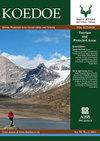克鲁格国家公园爬行动物发生数据的抽样偏差
IF 1.1
4区 环境科学与生态学
Q3 BIODIVERSITY CONSERVATION
引用次数: 7
摘要
有效的生物保护和管理需要了解物种如何在广泛和精细的空间分辨率下进行空间分布,理想情况下还需要了解其分布模式的潜在决定因素(Hurlbert & Jetz 2007;Kery 2011)。然而,可能有助于为保护管理决策提供信息的物种地理数据往往是有限的,并且在收集策略中存在偏见(Franklin 2010)。例如,虽然博物馆数据库通常包括所收集标本的发生数据,但大多数博物馆藏品的主要目的是作为物种鉴定的参考目录,而不是物种分布制图(Newbold 2010)。值得注意的是,尽管一些博物馆标本是直接作为系统采样的结果而收集的,但许多标本是偶然收集的(Kadmon, Farber & Danin 2004;Pyke & Ehrlich 2010)。因此,博物馆数据的收集工作和空间覆盖范围自然会根据收藏的兴趣而变化。尽管如此,最近对物种分布信息的需求日益迫切,这使得人们更加重视使用博物馆数据库来收集物种发生记录(Syfert, Smith & Coomes 2013)。本文章由计算机程序翻译,如有差异,请以英文原文为准。
Sampling bias in reptile occurrence data for the Kruger National Park
Effective conservation and management of organisms require an understanding of how species are spatially distributed at both broad and fine spatial resolutions, and ideally also the underlying determinants of their distribution patterns (Hurlbert & Jetz 2007; Kery 2011). However, species geographic data that may help inform conservation management decisions are often limited and biased in their collection strategies (Franklin 2010). For example, although museum databases often include occurrence data of collected specimens, the principal purpose of most museum collections is to act as reference catalogues for species identification rather than for species distribution mapping (Newbold 2010). It is important to note that although several museum specimens are collected directly as a result of systematic sampling, many specimens are collected opportunistically (Kadmon, Farber & Danin 2004; Pyke & Ehrlich 2010). As a result, collection effort and spatial coverage within museum data naturally vary depending on the interests of the collection. Despite this, a recently increased urgency in the need for species distribution information has placed a greater emphasis on the use of museum databases for amassing species occurrence records (Syfert, Smith & Coomes 2013).
求助全文
通过发布文献求助,成功后即可免费获取论文全文。
去求助
来源期刊

Koedoe
BIODIVERSITY CONSERVATION-
CiteScore
3.30
自引率
0.00%
发文量
10
审稿时长
20 weeks
期刊介绍:
Koedoe, with the subtitle ''African Protected Area Conservation and Science'', promotes and contributes to the scientific (biological) and environmental (ecological and biodiversity) conservation practices of Africa by defining the key disciplines that will ensure the existence of a wide variety of plant and animal species in their natural environments (biological diversity) in Africa.
 求助内容:
求助内容: 应助结果提醒方式:
应助结果提醒方式:


